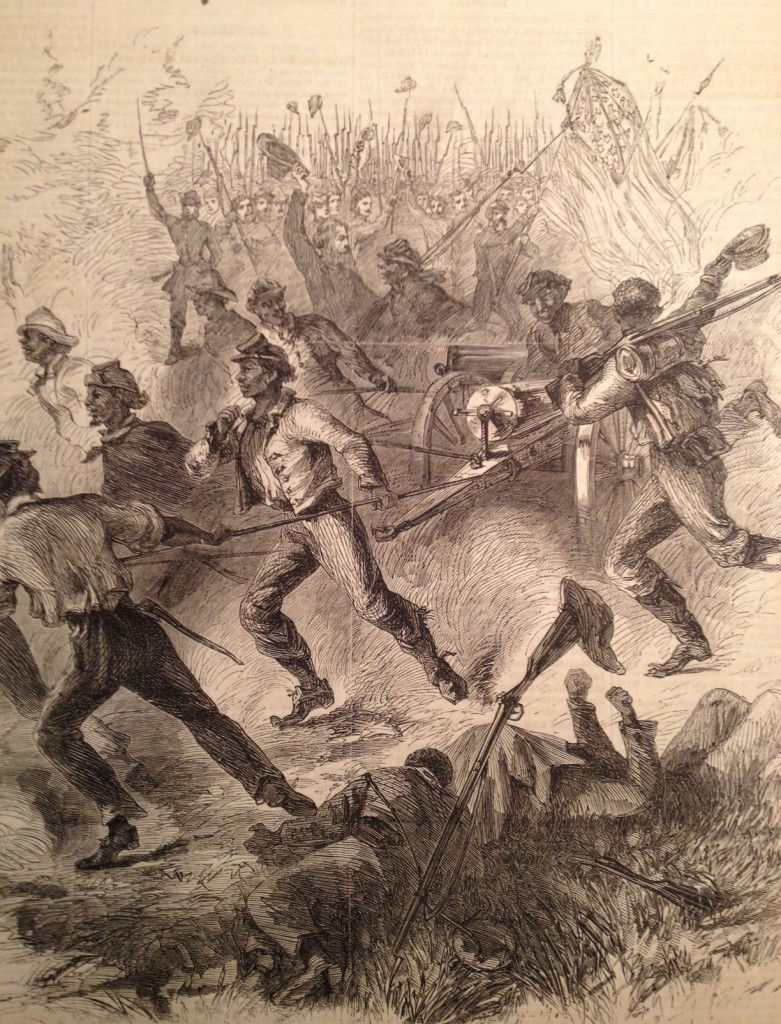Earlier today I was going through my collection of original Civil War era newspaper and came across an issue of Frank Leslie’s Illustrated from July 9, 1864. The first page includes this wonderful illustration of the charge of General Hinks’s “colored troops” outside of Petersburg in mid-June. Ohio troops cheer them on in the background. It’s a wonderful find as I continue to explore how white Union soldiers responded to the use of USCTs a few weeks later at the Crater.
It’s a powerful image, but we should proceed carefully in interpreting it. For some it is an image that fits into a popular and satisfying narrative that is framed around slavery, emancipation, military service, freedom, postwar promises of civil rights, and the eventual slide into Jim Crow. From this perspective we may be tempted to dismiss the cheering of the Ohio men as something fleeting or, in hindsight, even insincere. Such an interpretation, however, misses a salient point about white Union soldiers. They were not engaged in a civil rights struggle.
To me the image highlights a respect that black men earned on and off the battlefield as a result of donning the blue uniform. Blacks and whites experienced the same hardships and dangers and were united in the goal of putting down a rebellion and preserving the Union. Historians such as Barbara Gannon, Andrew Fleche, Caroline Janney and others have convincingly argued that it is this respect that continued through the postwar years in G.A.R. Halls, historical accounts and other forms of remembrance.
The positive reception that blacks enjoyed from their white comrades on many battlefields (though certainly not all) was fragile and could be easily undone depending on the outcome of the next battle and news from Washington, D.C. and the home front. The same men who cheered one day could slide right back into a virulent racist rant the next day. It’s a complex picture that is not easily or neatly explained.

“The positive reception that blacks enjoyed from their white comrades on many battlefields (though certainly not all) was fragile and could be easily undone depending on the outcome of the next battle and news from Washington, D.C. and the home front. The same men who cheered one day could slide right back into a virulent racist rant the next day.” Ah-ha! So “the cheering of the Ohio men” was “something fleeting” in many cases, and therefore that interpretation doesn’t completely miss “a salient point about white Union soldiers.” You contradicted yourself! 😀
Perhaps you worded your that last paragraph incorrectly. Maybe it would have been better to add that those “virulent racist rants” by the men who had cheered earlier were an expression of frustration and anger, and not necessarily sincere. Humans beings are not always inconstant in their views, and when they do change them, they might not revert to their previous viewpoint so easily, regardless of how long they have held their new one. Some of the Caucasian Union troops who had seen the USCTs perform admirably and changed their perception of them accordingly might have already had their new, more enlightened outlook (although many certainly still thought African Americans inferior in other respects) deeply entrenched in their minds by the time of the disaster at the Crater. Those who retained their prejudices might have cheered because they didn’t want to look unpatriotic to their comrades. Others might not have known what to think, and cheered for the same reason as the bigots. Then there were probably still others who were as fickle as you suggest, or stood by the loudest, most emotional voice. There undoubtedly also were soldiers who didn’t think of African American troops in terms of the Race or even the USCT as a whole. As you say, “It’s a complex picture that is not easily or neatly explained.”
In my own time in the service during the later part of the Vietnam War, anyone, of any color or race, was often ridiculed by what was then the ‘anti-war’ crowd.
All of us in the service/US Army considered ourselves all green, the color of our fatigue uniforms. Perhaps this feeling of shared service was even present at that time between USCTs and white US soldiers.
One can hope.
Sincerely,
Neil
I’ve heard it said that there is no Black or White in the trenches. I don’t know how true this is, never having served in battle myself; but it seems that there is something to the notion that the brotherhood forged in battle can overcome some pretty dramatic prejudices. This is most obvious in integrated units, but I am sure that even during the segregated era, the personnel of a white unit in reserve could watch a black unit go into battle and identify very closely with what the black personnel experience. One learns mighty fast that blacks’ blood runs just as red, and whites can be just as cowardly.